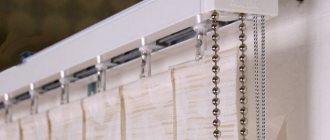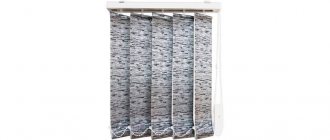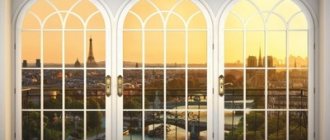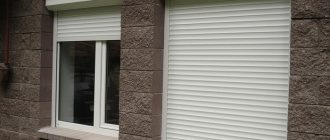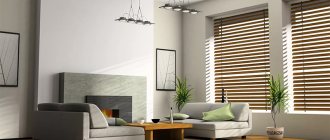In this complete guide to choosing blinds, you'll learn:
- What benefits do blinds offer you?
- What criteria should you rely on when choosing?
- 5 types of blinds: horizontal, vertical, classic, roller blinds, cassette.
- About the materials from which blinds can be made: how do plastic products differ from aluminum ones? What about bamboo versus wooden ones?
- How to choose the right blinds for your room and how not to make a mistake with the size?
Go.
Types of blinds
First you need to decide on the type of structure. Ease of use, mounting method and appearance depend on this.
For interesting details about blinds, watch the video:
Horizontal
The most common type. The slats (curtain strips) here are located parallel to the window sill, and their width varies from 16 to 25 mm.
Horizontal systems are successfully used both in residential premises and in offices, as they have a number of advantages:
- They take up little space and free up the window sill for other purposes:
- The slats can be installed at the desired angle to adjust the light level. You can also easily lift the entire panel and completely open the window opening.
- You can choose different installation methods: on a double-glazed window, on a frame, on a wall.
This category is not only the most popular, but also the most diverse in material and design.
The main thing you should focus on when purchasing this type of product is the thickness of the lamellas. It should be at least 0.2 mm. The wider the structure, the thicker the planks must be: this will prevent them from sagging.
Vertical
Vertical curtains are often found in institutions, but at home they are hung mainly in spacious apartments. Sometimes they are used to zone space and separate one part of the room from another. The strip width is 89 or 127 mm.
They are usually attached to the ceiling, and their height can vary: to the window sill or to the floor. To prevent the curtains from flying apart, they have a weighting material at the bottom.
It is better to purchase blinds with plastic weights: they do not leave rust marks like metal ones.
Design features allow you to decorate openings of unusual shapes, such as arched ones. They are usually sewn from fabric, which opens up wide design possibilities: they can be shortened to the desired length and one fabric strip can be changed for another, at the request of the owners, for example, in summer and winter.
The level of illumination is regulated due to the fact that each strip is able to rotate around its axis and, thus, retain or transmit light. Such models slide apart like regular curtains. In some cases they are divided into two halves and move apart, while in others they gather towards one edge.
Roll and cassette
Strictly speaking, these are already curtains, since there are no slats. Instead, a piece of material of varying degrees of density is used, which is collected up or down. This is how the dimming is adjusted.
The variety of colors is amazing, so you can choose the appropriate product for any room.
Structurally, roller blinds and cassette curtains are not too different. The first, as the name suggests, is a roll of fabric, the edge of which hangs down freely and, if necessary, is wound around the base.
The cassette type is characterized by the presence of a box in which the roll is placed. At the same time, guides running along the edges of the sash hold the canvas. It turns out that such a curtain no longer hangs down, but has a rigid fixation. This is especially convenient on PVC windows, which can be opened at an angle to the “ventilation” position. This system looks discreet and matches the color of the frame, so it does not spoil the interior. But it also costs more than the roll version.
Pleated
This is a canvas made of fabric or paper, folded like an accordion. There are holes on both sides through which a thin guide passes. Because of this, the curtains are easy to raise and lower, adjusting the darkening rate. In this case, the cut can be placed as desired: at the top of the window opening, in the middle or at the bottom.
The system is installed on a frame and can cover a window of any shape.
A little history
Most likely, such “window clothing” as blinds originates in countries with warm climates located in Asia, the Middle East, the Mediterranean and South America. They rarely used glass in window openings, replacing them with wooden planks placed motionlessly at an angle in the window opening, horizontally or vertically, or they used curtains made from plant stems tied together with ropes, which could be rolled up, thereby regulating the illumination of the room.
These devices were much more durable and practical than fabric curtains in conditions of high humidity, provided air circulation, regulated illumination and heating of the room by sunlight, allowed one to see quite freely what was happening outside and at the same time saved unauthorized persons from entering the house through window openings. Of course, they were not yet called “blinds.”
The production of blinds was officially patented in 1841 by the American industrialist John Hampton.
The word jalousie is of French origin and is translated as “jealousy.” It is assumed that the history of this name is rooted in the traditions of the East, where such designs were used on window openings, and there were strong traditions of hiding women from prying eyes. In Europe, blinds became very popular among courtesans, who intrigued men with the help of boards on strings, showing and hiding their bodies at the same time.
Over time, blind designs have improved, new materials and new possibilities have emerged that allow the most daring interior design ideas to be realized. Combined with ease of care and use, blinds eventually became very popular all over the world.
Material
In addition to design features, the appearance and durability of blinds is influenced by the material from which they are made. The choice of possible options here is very rich, so you will have to carefully weigh the pros and cons.
Aluminum
Aluminum lamellas can easily be called “classics of the genre”. When many people hear the word “blinds,” they think of white flexible strips, although today the range of similar products in color is very wide. There are even models with a special coating that imitates velor. Another trend is perforated slats. They create unusual lighting and look very interesting.
Metal samples are also good in use: they are durable, strong, do not fade or deform in the sun, and also have reflective properties. In addition, they are quite easy to wash, they are resistant to moisture and do not harbor harmful bacteria. Because of these properties, they are used in rooms with increased hygienic requirements: kindergartens, hospitals, etc.
However, you should know that aluminum strips bend easily, and it will not be possible to return them to their original appearance. Many are also annoyed by the rustling noise that such slats make in a draft.
Plastic
The most budget option. At the same time, the richness of colors and patterns cannot but please, which is why plastic models have become very widespread.
Such objects are quite durable and not prone to deformation. They are only afraid of targeted blows, which could cause them to break. Negative properties include their instability to high temperatures: in summer they can become very hot, which is why the geometry of the plastic is disrupted and the mechanism begins to work worse, eventually failing.
Colored samples have a tendency to fade, so you should not choose too active shades. But it’s easy to take care of the plastic: wipe it with a cloth and you’re done.
Tree
In the wake of the fashion for everything natural, wooden blinds have received a rebirth. It’s not surprising: these are warm, pleasant and cozy products. However, their cost is incomparably higher than that of plastic or aluminum analogues.
The mechanism is heavy and therefore not suitable for large windows.
Particular attention should be paid to the quality of the wood. It should be smooth and well polished. The panels are covered with several layers of varnish on top - it is better if it has ultraviolet protection so that the shade does not change from the sun.
Wooden objects have good consumer properties: durable construction, resistance to mechanical stress, long service life.
It must be taken into account that no matter how high-quality the coating is applied, the tree is still afraid of water. Therefore, it is better not to use it in rooms with high humidity (kitchen, bathroom).
For the same reason, wet cleaning is contraindicated for wooden blinds; only dry cleaning with a vacuum cleaner or brush is permissible. Particularly dirty areas can be wiped with a damp cloth.
Textile
Pleated, roller and vertical blinds are made from this material. The most obvious advantage: a rich palette of colors and textures.
Polyester, cotton, jacquard or fiberglass are used as the base. They are characterized by different densities and allow you to choose an option to create optimal illumination. There is also a special category of fabrics - blackout. It is completely lightproof and is often used to decorate the bedroom.
Any material must have a special impregnation that repels dust. Otherwise, the curtains get dirty very quickly and lose their appearance due to constant washing. Also, special compositions protect them from fading. As a result, care is limited to simply dusting; hand washing is required only in extreme situations.
Pay special attention to the edges: they must be well processed. Sticking threads and uneven edges gradually lead to even greater damage and not only the aesthetic component is lost, but the entire system may fail.
Bamboo
It looks like thin bamboo plates held together with thread in a variety of weaving patterns. There are two types of construction. In the first case, the rise is carried out like in horizontal models or pleated, and in the second - like in roller blinds (pictured).
Bamboo is light, not afraid of rays and washes well. It is impossible not to mention its environmental friendliness, since it is a natural raw material.
The main thing is the quality of the rods from which the fabric is woven. They should be smooth, without dark spots or signs of damage.
Room interior design options
When choosing blinds, first of all you need to take into account the individual characteristics of the room.
Such designs will be an ideal and high-quality solution for the kitchen. Blinds in the kitchen make using the window very comfortable.
Using blinds on bedroom windows not only allows you to protect the room well from sunlight and heat, but is also an excellent way to decorate.
Horizontal, vertical slats or pleated blinds in various bright shades of pink, turquoise, yellow or lilac, due to their practicality and functionality, are perfect for both a child’s room and a teenager’s room.
The photo shows a teenager’s room and bright two-tone pleated blinds on the window openings.
Various models, intelligently combined with the overall palette of the living room, will create a unique and stylish interior.
The photo shows the interior of the living room with horizontal bamboo slats on the windows.
Blinds on balcony windows are the most optimal and correct solution; they make it cozy and modern.
For the bathroom, choose products made from materials that are not afraid of high humidity and temperature changes. In addition, in the bathroom, slats can be used not only to decorate the window opening, but also to disguise communications or niches in which washing machines are located.
If the toilet has a window opening, then it can be decorated with both vertical and horizontal models, which can also be used as a screen and hide water or sewer pipes behind them.
The photo shows horizontal blinds on the window opening in the bathroom.
Mounting method
Blinds are also good because there are several mounting options for them.
- On the sash - for each half of the frame, its own canvas is installed. This makes it possible to conveniently open and close the doors. Before purchasing, you need to measure the width of the glass unit and add 3 cm to this value.
- On the frame - the window closes “at the same time”. This variety is more suitable for non-opening openings. It is also worth adding a few centimeters to the width on the sides, but at the same time make sure that the edges of the cornice do not rest against the slopes.
- On the wall - here you can choose the width of any size, depending on the configuration of the room. In this case, you can vary the height of the object: install it under the ceiling or directly above the opening, make it up to the floor, battery or window sill.
- This is how vertical blinds are attached to the ceiling. If floor length is expected, then they are usually located from wall to wall or to furniture, for example, a closet. If the product reaches the window sill or battery, then the width is made 10 - 15 cm larger than the opening.
The first two options can be combined with curtains, and the third and fourth types are used exclusively as an independent decorative element.
The tools for attaching blinds also differ. In some cases, mounting on brackets is required, in others it is correct to use self-tapping screws, and the lightest models can be mounted with double-sided tape. The choice is determined by the characteristics of the object: dimensions and weight. As a rule, fasteners are included in the kit, so you most likely won’t have to rack your brains about how best to do it.
The cornice can be made of plastic or aluminum. Obviously, the second one can withstand loads better and is therefore more durable.
Control
This parameter seems insignificant only at first glance. But imagine how many times a day you will have to adjust the dimming. At least in the morning and evening. Add to this an adjustment in the summer to limit the amount of light during particularly hot hours. And each time this requires your participation, but the amount of effort applied can vary greatly depending on the installed control system.
- Manual - adjustment is made using a rope, cane or chain. Not a very convenient variety for frequently opened windows. In this case, all adjusting parts should be on the side opposite the handle.
- Automatic (remote) – control is carried out using a remote control and an electric drive. It is very convenient, especially if heavy massive curtains are installed, or we are talking about a large house where you need to open/close many windows.
- “Smart home” is an expensive, modern and still little widespread system. Allows you to pre-program the required settings. The mechanism will operate at a predetermined time without human involvement.
Peculiarities
Despite their ancient origins, blinds for plastic windows remain relevant. This is due to their versatility, practicality and durability. They differ from simple curtains in their ability to regulate the light entering the room.
Modern blind designs consist of plates that move by electronic or mechanical control, that is, using an electric drive or chains or laces. The control mechanism is attached to a horizontal cornice . And the movement of the lamellas is carried out by a system of cords stretched through rings placed in the plates.
A beautiful, functional method of window decoration
The system serves as a complete or partial replacement of the room from the flow of light. Blinds have many advantages over simple curtains:
- Comfort. Using electronically controlled designs, you can adjust daylight lighting by pressing one button.
- Practicality. The systems are easy to maintain.
- Style. A variety of options for any interior.
Design
Here it is important not to overdo it or overload the interior. If you listen to our recommendations, you will be able to maintain a balance:
- the most universal color is white;
- models that are a couple of tones different from the color of the walls or furniture will look good;
- a contrasting shade or active pattern is suitable if you decide to focus attention on the window;
- black samples are appropriate in a minimalist interior, where the rest of the furnishings are white;
- in small rooms, light colors look great, visually expanding the space;
- if your apartment faces south, it is better to purchase curtains of a color that will help “cool” the atmosphere in the apartment: blue, green, turquoise, purple, and so on;
- peach, yellow, orange and brown shades can add comfort and warmth to the north side;
- The more spacious the room and the larger the window opening, the wider the slats can be.
To decorate fabric models, silk embroidery, gold or silver thread, ornaments, beads and beads are used.
Classification by size
There are main length options:
- Short. They save space and provide free access to windows and sills.
- Long. They look beautiful on panoramic or floor-length French window openings.


